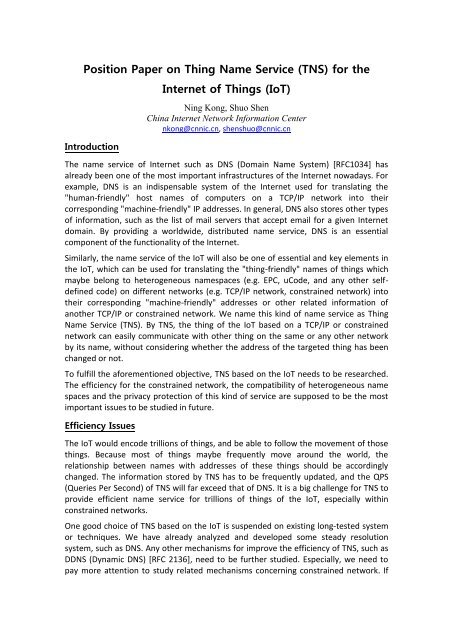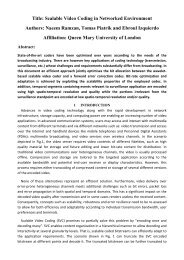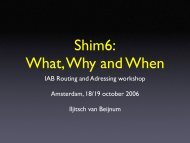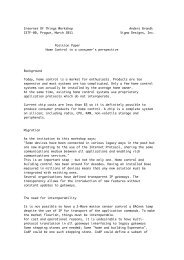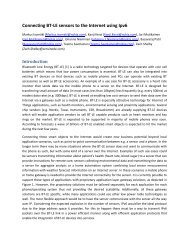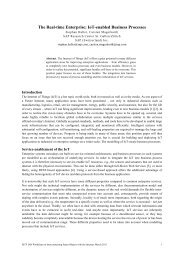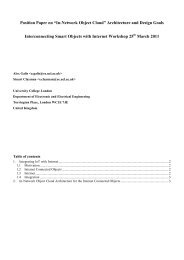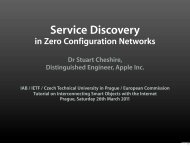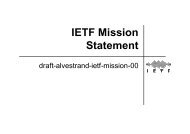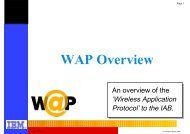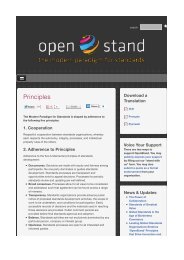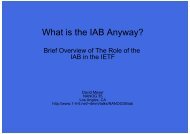Position Paper on Thing Name Service (TNS) - Internet Architecture ...
Position Paper on Thing Name Service (TNS) - Internet Architecture ...
Position Paper on Thing Name Service (TNS) - Internet Architecture ...
Create successful ePaper yourself
Turn your PDF publications into a flip-book with our unique Google optimized e-Paper software.
<str<strong>on</strong>g>Positi<strong>on</strong></str<strong>on</strong>g> <str<strong>on</strong>g>Paper</str<strong>on</strong>g> <strong>on</strong> <strong>Thing</strong> <strong>Name</strong> <strong>Service</strong> (<strong>TNS</strong>) for the<br />
Introducti<strong>on</strong><br />
<strong>Internet</strong> of <strong>Thing</strong>s (IoT)<br />
Ning K<strong>on</strong>g, Shuo Shen<br />
China <strong>Internet</strong> Network Informati<strong>on</strong> Center<br />
nk<strong>on</strong>g@cnnic.cn, shenshuo@cnnic.cn<br />
The name service of <strong>Internet</strong> such as DNS (Domain <strong>Name</strong> System) [RFC1034] has<br />
already been <strong>on</strong>e of the most important infrastructures of the <strong>Internet</strong> nowadays. For<br />
example, DNS is an indispensable system of the <strong>Internet</strong> used for translating the<br />
"human-friendly" host names of computers <strong>on</strong> a TCP/IP network into their<br />
corresp<strong>on</strong>ding "machine-friendly" IP addresses. In general, DNS also stores other types<br />
of informati<strong>on</strong>, such as the list of mail servers that accept email for a given <strong>Internet</strong><br />
domain. By providing a worldwide, distributed name service, DNS is an essential<br />
comp<strong>on</strong>ent of the functi<strong>on</strong>ality of the <strong>Internet</strong>.<br />
Similarly, the name service of the IoT will also be <strong>on</strong>e of essential and key elements in<br />
the IoT, which can be used for translating the "thing-friendly" names of things which<br />
maybe bel<strong>on</strong>g to heterogeneous namespaces (e.g. EPC, uCode, and any other selfdefined<br />
code) <strong>on</strong> different networks (e.g. TCP/IP network, c<strong>on</strong>strained network) into<br />
their corresp<strong>on</strong>ding "machine-friendly" addresses or other related informati<strong>on</strong> of<br />
another TCP/IP or c<strong>on</strong>strained network. We name this kind of name service as <strong>Thing</strong><br />
<strong>Name</strong> <strong>Service</strong> (<strong>TNS</strong>). By <strong>TNS</strong>, the thing of the IoT based <strong>on</strong> a TCP/IP or c<strong>on</strong>strained<br />
network can easily communicate with other thing <strong>on</strong> the same or any other network<br />
by its name, without c<strong>on</strong>sidering whether the address of the targeted thing has been<br />
changed or not.<br />
To fulfill the aforementi<strong>on</strong>ed objective, <strong>TNS</strong> based <strong>on</strong> the IoT needs to be researched.<br />
The efficiency for the c<strong>on</strong>strained network, the compatibility of heterogeneous name<br />
spaces and the privacy protecti<strong>on</strong> of this kind of service are supposed to be the most<br />
important issues to be studied in future.<br />
Efficiency Issues<br />
The IoT would encode trilli<strong>on</strong>s of things, and be able to follow the movement of those<br />
things. Because most of things maybe frequently move around the world, the<br />
relati<strong>on</strong>ship between names with addresses of these things should be accordingly<br />
changed. The informati<strong>on</strong> stored by <strong>TNS</strong> has to be frequently updated, and the QPS<br />
(Queries Per Sec<strong>on</strong>d) of <strong>TNS</strong> will far exceed that of DNS. It is a big challenge for <strong>TNS</strong> to<br />
provide efficient name service for trilli<strong>on</strong>s of things of the IoT, especially within<br />
c<strong>on</strong>strained networks.<br />
One good choice of <strong>TNS</strong> based <strong>on</strong> the IoT is suspended <strong>on</strong> existing l<strong>on</strong>g-tested system<br />
or techniques. We have already analyzed and developed some steady resoluti<strong>on</strong><br />
system, such as DNS. Any other mechanisms for improve the efficiency of <strong>TNS</strong>, such as<br />
DDNS (Dynamic DNS) [RFC 2136], need to be further studied. Especially, we need to<br />
pay more attenti<strong>on</strong> to study related mechanisms c<strong>on</strong>cerning c<strong>on</strong>strained network. If
necessary, we should develop some new mechanism to improve the performance of<br />
<strong>TNS</strong> within c<strong>on</strong>strained networks.<br />
Compatibility Issues<br />
There are multiple code standards for things related with the IoT such as EPC<br />
(Electr<strong>on</strong>ic Product Code) and uCode (ubiquitous Code). In the future, there may be<br />
more code standards for things, for example some self-designed code standards by<br />
different industries or countries. So these heterogeneous code standards can cause<br />
the c<strong>on</strong>flict problem of the name service for the IoT. <strong>TNS</strong> should support all different<br />
code standards for things in the IoT, although DNS <strong>on</strong>ly needs to support <strong>on</strong>e code<br />
standard named as domain name.<br />
Our idea about compatibility of <strong>TNS</strong> is to design multiple ID resoluti<strong>on</strong> service<br />
architecture and resoluti<strong>on</strong> protocol. Currently, we have already partially developed a<br />
test system of <strong>TNS</strong> based <strong>on</strong> Dynamic Delegati<strong>on</strong> Discovery System (DDDS) [RFC 3401,<br />
RFC 3402, RFC 3403, RFC 3404, and RFC 3405] which can provide name service for EPC,<br />
uCode and any other self-defined codes. For more informati<strong>on</strong>, please refer to the<br />
Appendix “A Model Supporting Any Product Code Standard for the Resource<br />
Addressing in the <strong>Internet</strong> of <strong>Thing</strong>s”.<br />
Privacy Issues<br />
The privacy protecti<strong>on</strong> of the IoT has caused wide public c<strong>on</strong>cern. This kind of problem<br />
also exists in the name service for the IoT, since the informati<strong>on</strong> of relati<strong>on</strong>ship<br />
between names with addresses of things in <strong>TNS</strong> may leak the privacy of clients. It is<br />
important to protect the privacy of informati<strong>on</strong> provided by <strong>TNS</strong> that it is not divulged<br />
to malicious parties. By now, DNS doesn’t c<strong>on</strong>tain any mechanism of privacy<br />
protecti<strong>on</strong>, so it’s necessary to design <strong>TNS</strong> by any other mechanism except DNS.<br />
Firstly we need to make sure the problem statement of privacy protecti<strong>on</strong> of <strong>TNS</strong>.<br />
Then we should analyze exist privacy protecti<strong>on</strong> approaches for <strong>TNS</strong> of the IoT. Fox<br />
example, Handle system [RFC 3650, RFC 3651, and RFC 3652] is better than DNS in<br />
regard to privacy protecti<strong>on</strong>. But the scalability of Handle system is not as good as DNS.<br />
It is possible that we need to modify some existing protocols of <strong>Internet</strong> or design<br />
some new protocols to realize the functi<strong>on</strong> of privacy protecti<strong>on</strong> for <strong>TNS</strong>. This kind of<br />
issues needs to be further studied.<br />
C<strong>on</strong>clusi<strong>on</strong><br />
In our opini<strong>on</strong>, <strong>TNS</strong> will be <strong>on</strong>e of essential and key elements in the IoT, just like DNS in<br />
the <strong>Internet</strong>. Because of trilli<strong>on</strong>s of c<strong>on</strong>nected things or c<strong>on</strong>strained devices, IoT has<br />
different characteristics against <strong>Internet</strong>. So there are more challenges of <strong>TNS</strong> than<br />
those of DNS. We divided new challenges of <strong>TNS</strong> into three categories: efficiency,<br />
compatibility and privacy. It is not feasible that reusing DNS protocols to realize <strong>TNS</strong><br />
because of these new challenges, especially privacy issues.<br />
Efficiency, compatibility and privacy issues of <strong>TNS</strong> need to be further researched. Some<br />
problems related to efficiency and compatibility of <strong>TNS</strong> should be c<strong>on</strong>sidered by IETF<br />
CoRE working group in future. We suggest other problems in terms of privacy of <strong>TNS</strong><br />
should be c<strong>on</strong>sidered by IRTF as l<strong>on</strong>g term research items.


